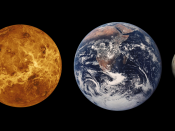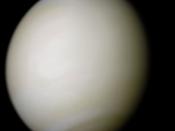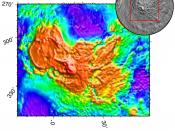Planet Report:
Venus
By: Kim
Mr. Montgomery
Period 5
Venus: The Boiling Planet
A planet with surface temperatures that can melt lead and atmospheric pressure that can crush a man where he stand- Venus is the most hostile of the terrestrial planets. Though scientists think that this barren rock may once have been much like Earth.
Venus is known as Earth's "sister planet", they both share similarities in: size, mass, density and volume. Both formed around the same time, but are not exactly the same. In contrast Earth has oceans whereas Venus does not, also their atmospheres are unlike on another. Venus's atmosphere is made up mainly of nitrogen and carbon dioxide.
It is said that if Venus wasn't located so close to the Sun, the formation of the oceans would have lasted. The distance between the sun and Venus is 108,2000,000 km and because of the close proximity to the Sun temperatures roar at about 482ú C (900ú F).
Other interesting things about the planet are it's sulfuric clouds and rain, it's so called "blob tectonics" and it's relatively young surface. Venus's surface only checks out to be 500 million years old (based on Russian carbon-dating of planetary rocks). The exact reason for it being so young remains unknown, but because Venus lacks Earth's major plate tectonics it is speculated that every so often enough pressure builds up in the planet's interior to trigger a catastrophic eruption of all the planets volcanoes. This mass eruption then acts as a planetary Zamboni and resurfaces the entire rock.
The boiling planets' surface is covered by thousands of dome-like structures, each several kilometers across. These circular mounds are thought to be caused by magma within the planets crust pushing up against the surface. Sometimes the lava subsides, and the dome collapses, creating...


